Since I was a boy learning about them in the hallowed yellow-trim pages of National Geographic, cultures that have developed with a need to hunt for survival have captivated my imagination. Today, as an avid and reasonably well- travelled hunter, I have been lucky enough to hunt with some of these ancient cultures and experience their skills first hand. Earlier this year I decided to fulfil an ambition to hunt with the Inuit inside the Arctic Circle. I have long been fascinated by how they go about harvesting from nature’s bounty in brutal subzero temperatures and wondered if I would be able to cope with such extremes.
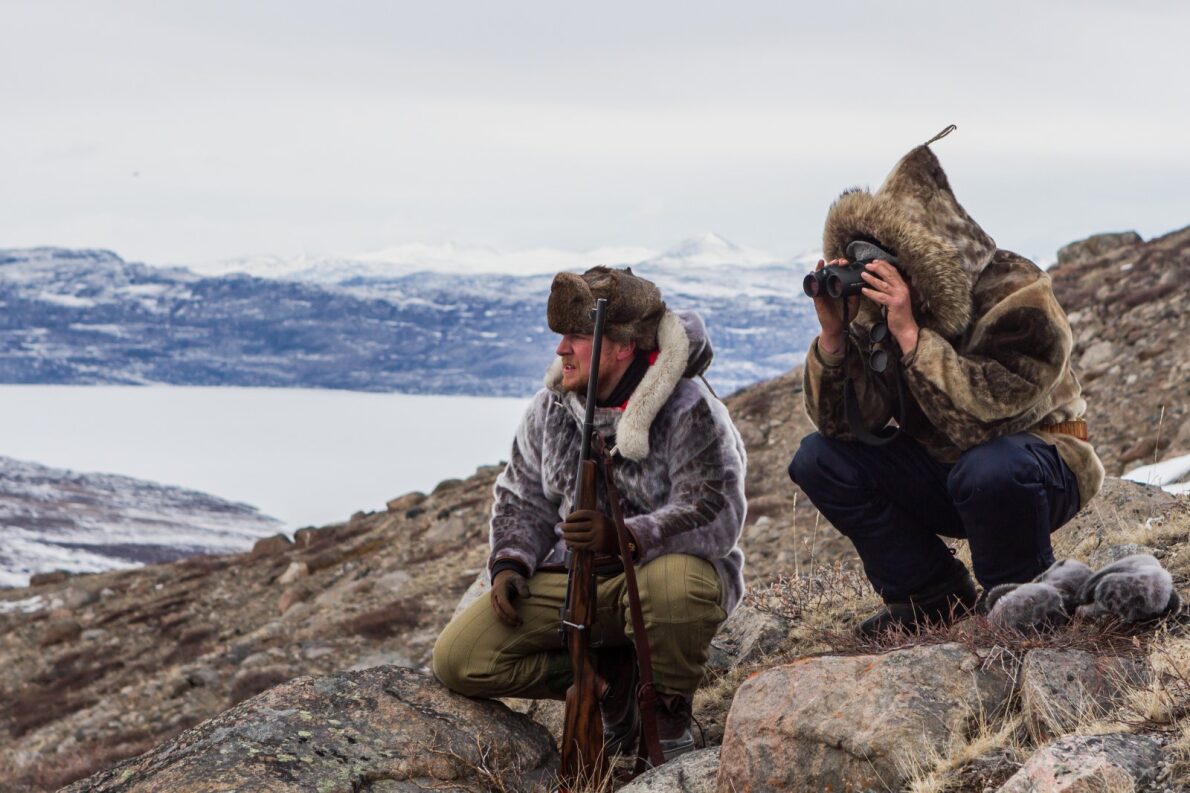
Since Greenland was colonised some 5,000 years ago, the diet of its inhabitants has mostly been made up of animal protein. The unforgiving landscape is simply too harsh for edible plants to prosper, making meat the only option. Today the country has advanced somewhat, with supermarkets supplied twice a year by container ship offering frozen vegetables, cereals and bread. However, the taste for meat persists. The survival of the Inuit is no longer solely dependent on the animals they hunt, but the spoils are still a major source of sustenance inside the unrelenting harshness of the Arctic Circle.
Greenland is the original land of ice and snow. An autonomous country within the Kingdom of Denmark and the world’s biggest island, Greenland covers 2.2 million square kilometres. Quite simply it is a vast, bleak landscape of not a lot. It is the least densely populated country in the world, home to just 60,000 inhabitants with 89% of Greenlanders being Inuit, a people who until 50 years ago lived solely by subsistence hunting.
My polar safari started in Kangerlussuaq. Meaning ‘Big Fjord’, it is a settlement of 530 people in western Greenland – and by their standards a large town. Situated on the outer edge of the Greenland ice cap, which covers 80% of the country’s territory and is the second largest body of ice in the world after Antarctica, Kangerlussuaq used to be home to an American air base, founded in 1941.
It closed in 1992 with the threat of the Cold War subsiding. The area surrounding the town is home to many species of Greenland’s endemic fauna.
The Inuit are highly skilled hunters. Their sustainable, no-waste hunting encompasses caribou, polar bear, seal, walrus, king eider duck, ptarmigan, Arctic hare, Arctic fox and the mighty muskox. Every morsel of all harvested game is used in some way. In addition they also hunt beluga, minke whale and narwhal using a highly respected and traditional method in which the animals are hunted from small boats using harpoons attached to sealskin bladders to prevent them from diving. I can only imagine the courage it must take to throw a harpoon from a canoe at a five-ton, 7m-long creature that lives beneath the dark, icy water.
New clothes
My first intake of cold Greenlandic air was quite literally breathtaking. The insides of my nostrils froze when faced with the fierce bitter air. It became instantly apparent that
my buffalo and kudu skin safari boots weren’t going to withstand the -25°C temperatures and a quick change into fleece-lined and insulated Sorels was needed.
After landing I met my guide, Karsten Lings, the first outfitter and guide from this area of Greenland. Leaving the rudimentary airport, we drove past charming painted timber houses with sealskins stretched across frames, air-drying in the moisture-free subzero breeze. As we travelled the gravel road a few miles from town, I listened to Karsten’s story of a polar bear visiting the community a couple of years before. As the only predator on the planet to hunt and include human flesh in its diet, this story brought home the brutal nature of things that far north.
Accommodation was basic but cosy – a simple cabin with a wood burner and no electricity, nestled on the edge of the spectacular Kangerlussuaq Fjord with far- reaching 360° views. At 190km long and between 1.5km and 8km wide, the fjord is the longest in western Greenland and frozen between December and June each year. The cabin, my base for the next three nights, became a welcome warm haven after the physical and mental challenge of hunting in subzero temperatures.
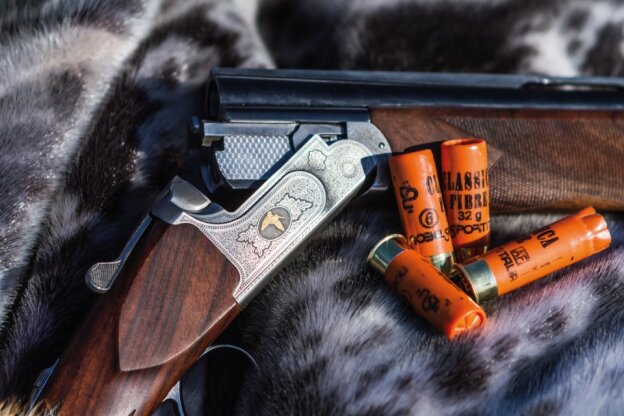 A decent shotgun is something of an essential in the frozen north!
A decent shotgun is something of an essential in the frozen north!
Day one
My first day’s hunting started with a sunny view of the fjord and the wind-scoured mountains running alongside that reminded me a little of the Scottish west coast. After a breakfast of eggs and fish, I got onto a snowmobile behind Jan Pedersen, one of Karsten’s experienced guides. Our first expedition would be to travel the fjord with a shotgun for Arctic hare. Dog sleds were the most popular mode of transport until a few years ago, when snowmobiles took over as a more effective means of getting around the barren landscape.
Riding the snowmobile over the frozen fjord was focusing. The ice needs to be a minimum of 10cm thick to support the weight of the vehicle and violent storms known as piteraqs can blow off the ice cap without warning. I had to put my trust in Jan and put out of my mind stories of people falling to their doom through unseen fissures in the ice. Before long a bigger worry was that my high-tech man made fibre clothing was no match for the extreme cold and the wind chill sapped my body temperature.
Fortunately a thick sealskin smock adorned with a hood trimmed in sled dog fur soon remedied the problem.
The good thing about the bitter cold is that animals favour the edge of the fjord, and after glassing the mountainous edges we spotted the first of our chosen quarry sitting in some windblown snow in a small gully.
The brilliant white of the Arctic hare acts as a cloak of invisibility against a pure white background. Stalking to within shotgun range, we traipsed over the broken edges of the fjord – a delicate business. Because the fjord is tidal, the ice shelf rises and lowers on each tide, breaking the sides against the rocks. This creates deep crevices and peaks that needed scaling to get to the land. After negotiating this obstacle course, we were ready to walk up to the hare between rock valleys and snowdrifts. When flushed, the hare bolted higher up the rock face, offering some spectacular sport with the shotgun and an excellent start to my trip.
Having taken two brace over the course of a few hours, we secured the game to a sled behind the snowmobile. Jan then suggested a few hours of traditional Inuit ice fishing, with handlines and hooks baited with rubber lures. Cutting a one metre deep hole into the hard-packed ice at the edge of the fjord with a sharp metal-tipped spear offered a welcome warm up. The fish were hungry and we had soon hooked around a dozen Arctic cod, which grow to 30cm long and are the favourite food of narwhals and other Arctic whales. Our catch was destined for various purposes: we would traditionally air-dry some to snack on, use some for a fish stew, and leave some as bait for Arctic fox. By then I was starting to lose the battle with the cold. It was time to head back to the cabin for some warm food and an early night.
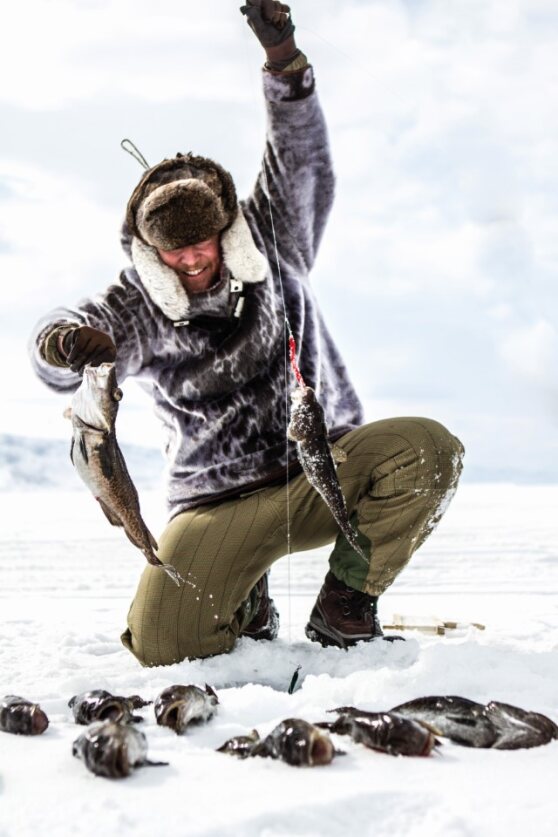 It isn’t exactly fly fishing, but it’s certainly effective!
It isn’t exactly fly fishing, but it’s certainly effective!
Day two
My second day saw us back on the ice with Arctic fox and ptarmigan in our sights. The Arctic fox, also known as the white, polar or snow fox, is native to the Arctic regions and well adapted to living in cold environments. They have thick, deep fur, a good supply of body fat and a system of countercurrent heat exchange in the circulation in their paws that helps them retain core body temperature.
Averaging about 85cm in body length, Arctic foxes prey on any small animals they can find, including Greenland lemmings, and will also eat carrion, berries, seaweed and, I hoped, Arctic cod. Bound up in much of the Arctic people’s mythology, the fox is a source of both fur and meat and over the past couple of hundred years has provided considerable income to the local community. As we neared the previous day’s bait, I loaded the rifle. We cornered into sight of the bait and saw a white flash making for the safety of land, disturbed by the noise of the engine. The snowmobile slithered to a standstill. The skid supported the rifle’s forend like a bipod as I lay on the ice lining up on my first Arctic fox. I took a confident shot with the 6.5x55 at over 200m using a little holdover to compensate. The fox dropped motionlessly. Remarkably, another, this time with a brown coat, appeared from some ice at the edge of the fjord, a little further away than the last. I cleanly dispatched it within seconds of the last and from the same position. Foxes are wily adversaries and a brace on one hunt was a rarity, particularly in two colours.
Despite its inhospitable landscape, Greenland is actually home to around 235 species of birds, the majority of being migratory. Ptarmigan are Greenland’s only gallinaceous bird. They breed all over the country and can be seen on any sort of terrain. They are a popular delicacy and make for challenging shooting, changing their plumage from a well-camouflaged brown in the summer to completely white in the winter to hide between rocks and snow. The style of shooting these stunning birds followed the same format as hunting the hare; spotting followed by a clamber made for some hard and rewarding sport. After a highly memorable day, fish stew beckoned so we left the ice.
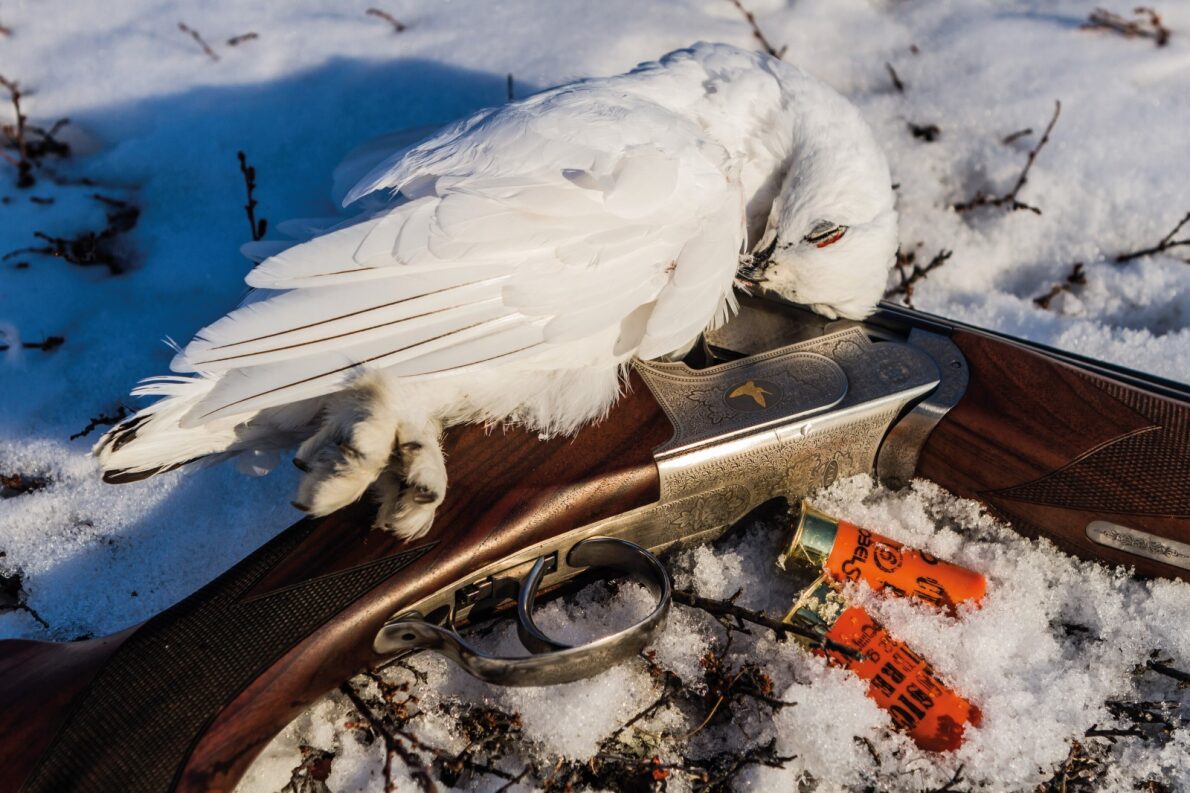 Ptarmigan are a real challenge in these snowbound conditions
Ptarmigan are a real challenge in these snowbound conditions
Day three
I woke early on day three filled with excitement about my hunt for muskox, a creature that looks to me like a polar buffalo.
The sky was overcast, which had led to a noticeable rise in temperature, making the long journey across the frozen fjord considerably less painful. I had chosen to take my open-sighted .416 Rigby Big Game rifle and its accompanying Hornady DGX (Dangerous Game Expanding) 400gr ammo to topple this large thick-coated mammal.
Known in Greenlandic as ‘umimmaq’, meaning ‘long-bearded one’, the muskox is a tundra dweller more closely related to goats and sheep than true cattle. In 1958 27 muskox were released near Kangerlussuaq onto an open hunting district of some 6,600 square kilometres. Over the space of 40 years the population is estimated to have grown to at least 7,000 individuals. With plentiful food, they grow 15% larger than elsewhere in Greenland. A fully grown bull is able to reach a weight of 400kg and likely to attack if it feels threatened. These animals must be treated with the utmost respect.
Karsten explained that the animals move 100km over the year in their habitat range, existing in big groups during the winter and then splitting up during the spring and entering the rut in August. The females live to around 25 years old, while the males reach 15-18; both lose around 40% of their body weight during the winter. Management is vital for the health of the herd and numbers today are stable thanks to hunting for their skin, incredibly well insulated fur and meat, which is highly valued on the open market.
Little stirs in Greenland. When the snowmobile stopped, the only sound I could hear over my tinnitus was ice sizzling onto the hot exhaust like sausage fat onto a barbecue. I marvelled in the vastness of the scenery. A bit of walking leads to sweating and overheating, which in turn leads to chilling. Taking off a glove to adjust a camera or scope can result in aching fingers and near frostbite. Existing in such extreme cold draws hugely on the body’s fuel reserves and requires careful and close attention.
With the snowmobile unloaded, we started our long hike onto the tundra in search of these magnificent prehistoric- looking animals. Muskox are not the hardest creatures to hunt but the conditions are brutal, making it a superb sporting challenge. There are no trees on the tundra, or indeed anywhere in Greenland, and the beasts usually have the high ground advantage, so planning a long downwind route using dead ground is the only way to outsmart them. If they see or smell you they walk steadily away, taking you further from the relative safety of your snowmobile.
After a dedicated upward climb and a final crawl, I came up on my animal, which stood feeding in a group of three around 100m away. This was as far as I wanted to shoot with the express sights of my Rigby. I rose up and took the first shot freehand without the animals realising I was there. With the absence of seeing a reaction through a scope, I immediately took another insurance shot. The mature bull ran a matter of metres and toppled. The satisfaction was immense. By luck we managed to get the snowmobile quite close to the animal to load so that we could haul it out and skin it closer to the safety of camp.
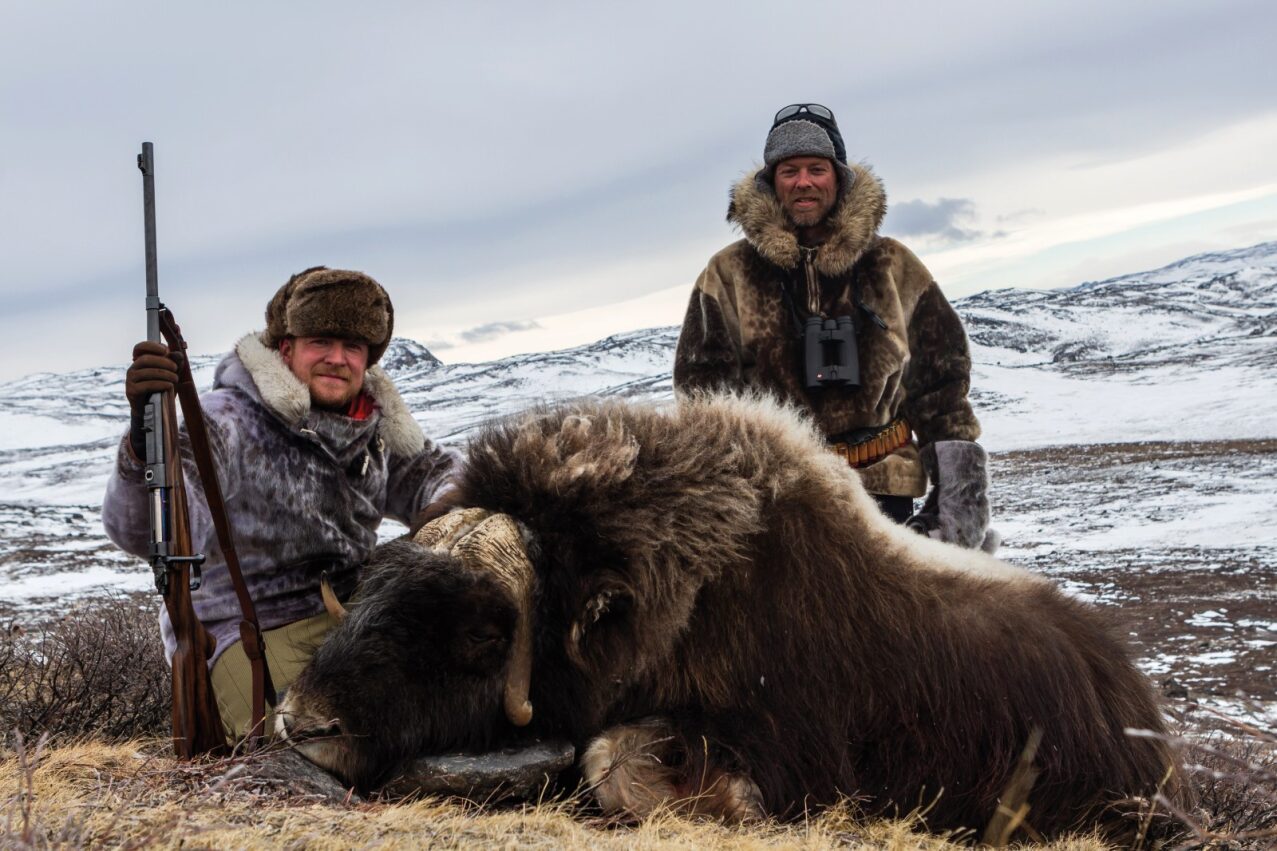
With the muskox skinned and efficiently butchered, it was nearly dark. A short walk to the cabin and hot food almost signalled the end of my adventure. I had one last task to perform before heading back to the UK. To avoid stinking out the cabin, I sat outside using the light of a head torch to skin both Arctic foxes in readiness for the tanners. As I picked at the paws with a scalpel, I looked up at what had been a dark sky and was greeted by a sight as beautiful as a glorious sunset swirling across the sky like isobars on a pressure map. Green hues lifted like morning mist and while watching I lost a sense of time. I had successfully taken all the animals I set out to shoot and now I was lucky enough to have a fine display of the northern lights, which is by no means guaranteed.
Hunting in Greenland in such unrelenting conditions is a unique adventure and one I would highly recommend. Hunting alongside Karsten and his team, and seeing how well adapted the Inuit are to the extreme cold, has given me enormous respect for this ancient and fascinating culture.
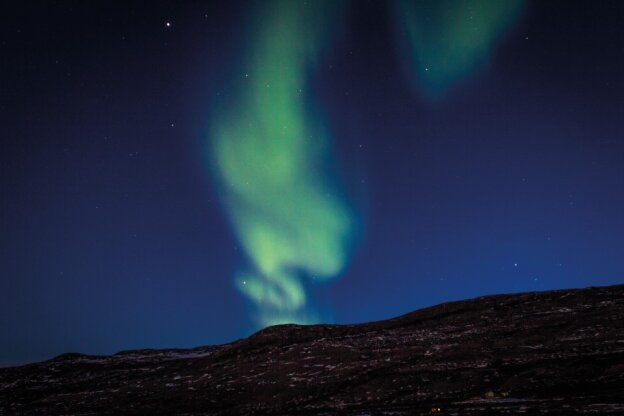 The finishing touch to what was an epic trip – the Northern Lights in all their glory
The finishing touch to what was an epic trip – the Northern Lights in all their glory